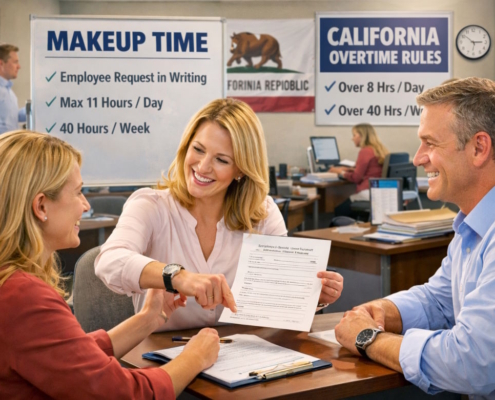Related blogs:
How much paid sick leave do workers get in California?
The new paid sick leave law in California became fully operational on January 1, 2024. Among other things, it increased the bare minimum of paid sick leave from twenty-four to forty hours, or five days. It is imperative that all businesses with employees in California are aware of and comply with the new regulations.
Which employees qualify for paid sick leave
Anyone working for the same company for more than 30 days in a calendar year and who have gone the full 90 days without taking sick leave is subject to the new regulation in California. The law also protects temporary workers, those who work from home, and those who operate on a per-diem or per-hour basis. While most employees will be able to take use of the new law’s perks, there are a few who won’t:
-Those who work for airlines, if they get vacation time that is similar to what the new law offers
-Railway workers
-Employees covered by collective bargaining in the construction industry
-US intelligence workers who have retired but can still be assigned work.
Keep in mind that collective bargaining agreements have revised the requirements for exemptions, guaranteeing that these employees will receive the same or better sick leave benefits from their companies. The new regulation does shield exempt workers from having to fill in for absent coworkers when they call in sick.
Concerns regarding seasonal employees
Businesses should be aware that there are regulations in place to assist seasonal employees. For example, the ninety days of employment are not required to run continuously. A company is required to pay an employee back for time worked if they leave during a 60-day period but come back within the same calendar year. This rule does not apply to employees who used their paid sick leave benefits before their initial employment ended. As with any new hire, these employees will need to begin accruing time from the beginning.
The new California law and its effects on paid sick leave
The state of California raised the minimum amount of paid sick leave from 24 hours to 40 hours or five days, whichever is more. However, the new law also altered the worker’s use restrictions. In the past, workers could only take a maximum of three days or twenty-four hours of paid sick leave per year, with a six-day maximum total. The limit has been increased to five used days each year, with the accumulation limitation now set at 80 hours, or 10 days. It is essential for organizations to grasp the new criteria because the changes in days/hours have enormous practical ramifications.
An explanation of California’s days/hours requirement
The days/hours rule can make a big difference in how much time off people get, especially if they work long hours every day. Working an 11-hour day would entitle an employee to fifty-five hours of paid sick leave annually (5 days x 11 hours). That’s because, according to the law, you can only get the longer of 40 hours or five days. The number of hours worked was more significant in this case. On the other hand, a worker who puts in seven-hour days will still be eligible for the full forty hours of paid sick leave, even though their quota is only thirty-five hours.
When discussing local statutes, there is one key difference. The company must nonetheless follow the higher local requirement for paid sick leave even if it is higher than what the state law mandates. The reason behind this is that as a general rule, businesses are required by law to adhere to the rule or benefit that is most helpful to the employee.
However, in cases where there is a discrepancy between state and local laws regarding sick leave, the state law will take precedence. This includes issues like the calculation of sick leave, the timing of sick leave payment, the notice requirements, and payment upon termination.
A variety of paid sick leave accrual possibilities
There are numerous possible accumulation situations for sick time. The new regulation in California, however, mandates that all businesses stick to a 1:30 timetable. In other words, for every thirty hours worked, you will earn an hour of sick leave. On top of that, by the 120th day of employment, employees need to have accrued 24 hours. Employees are required to have access to the entire 40 hours by the 200th day of employment.
These are the bare bones of paid sick leave accruals, but there are a lot of options for how companies do it.
Up-front policy
At the beginning of each year, employees are now required to have forty hours, or five days, of sick leave available, as per the new minimum requirement. The entire allotment of paid sick leave, if granted upfront, must be accessible at the start of the year.
The time accrual period of 12 months
When determining paid sick leave, companies are free to use whichever time frame they see fit. Some people’s fiscal years begin and conclude in January and December, whereas others’ work years follow a calendar year. An alternative would be for employers to use the anniversary date of hire as the basis for timekeeping. Any approach can be considered valid.
Prorating employee hours according to calendar term and number of days due workers is an option for employers who want to switch from an up-front to a delayed accrual strategy. Companies also have the option of starting over with fresh financial records. Keep in mind that the legislation has recently changed to provide yearly limitations on use of up to 40 hours or five days, and maximum ceilings on accrual of 80 hours or 10 days.
Protections against retaliation
The law makes it harder to be fired for taking sick days, and it includes detailed rules about what counts as retaliation after complaints.
Current employee benefits and paid time off
Companies that provide their employees with paid time off (PTO) plans are in compliance with the law if the plans fulfill the minimal requirements for accrual time and total calendar year guarantees set by the state. Once again, that’s forty hours, or five days. Company policies are in line with regulations if they provide paid time off that exceeds five days. Paid sick leave must be able to add up to ten days, or 80 hours, under PTO plans.
Regardless of whether PTO has traditionally been reserved for vacation purposes, organizations are nonetheless considered compliant with the new paid sick leave law rules in California if the amount exceeds the threshold. Companies are under no obligation to provide more time off than what has previously been granted.
Companies that offer unlimited paid sick leave are subject to the same regulations. Since “unlimited” goes beyond the 40-hour state minimum, companies should just make a note on employees’ pay stubs that their PTO is unlimited.
What the new law lets you do with paid sick leave
People can use their paid sick leave for many things, like taking care of themselves or a family member. Among the authorized uses are:
-Health screenings for workers and their families
-Care for a preexisting medical issue
-Assistance related to sexual assault, stalking, and domestic violence
-Routine checkups and seasonal vaccines
-“Family member” in this case means the employee or a parent, spouse, child, registered domestic partner, grandchild, grandparent, sibling, or other person named in the law.
Requirements for employer notification
If an employee plans to take sick leave, they need to let their employer know as soon as possible. Employees are required to provide maximum advance notice to their employers while taking planned sick absence, such as for surgery.
The safeguards afforded to employees by the paid sick leave statute in California
An essential safeguard for employees is the prohibition of employers from requesting evidence of a doctor’s visit, sickness, or treatment in order to justify the use of sick days. Instead, workers have the right to request sick time in writing or verbally. If an employer has evidence that an employee took time off for a fraudulent reason, they may request proof of the employee’s absence under specific conditions.
It is important to remember that employees can only utilize their accrued time for lawful purposes, as stated in the legislation. It won’t cover those sick days or unexcused absences when you have no accrued time. The company has the authority to penalize the employee for those unpaid absences. Beyond this, though, companies cannot penalize employees in any way for taking sick days that are already in their contracts.
The amount of sick leave an employee takes is entirely up to them. Employers cannot mandate minimal requirements, such as the use of full or half days for sick leave. When clocking in, employers can mandate a minimum of two hours, but employees are free to choose their own duration.
Accrued sick leave payments and records
Which employees are eligible to get paid sick leave is determined by their employee categorization. Paid sick leave should be a regular part of each pay cycle for non-exempt employees. Workers’ pay stubs would itemize their used paid sick leave, which would earn them their same hourly rate. The calculation of paid time off for exempt workers would be identical to that for regular vacations or sick days.
Employees are required to keep track of their sick leave hours on their pay stubs or another readily available means. A lot of companies offer software or online portals that employees can use to keep tabs on this data. With this level of openness, both employees and employers can easily handle paid time off.
Although the state determined the maximum amount of paid sick leave, employees cannot cash out their excess hours unless their business has a policy that allows it.
Important Points
On January 1, 2024, the new paid sick leave law in California took effect. It increased the minimum amount of paid sick leave that employers are required to provide from three days or twenty-four hours to five days or forty hours, whichever is higher. Because different employees may have different daily work schedules, it is critical for businesses to comprehend the days/hours requirement.
There are a variety of methods for accruing paid sick leave; the specifics will vary from employer to employer and from one calendar year to the next. Employers can choose to adopt an all-up-front distribution or have employees accumulate hours gradually over time. Workers are required to have access to a minimum of 24 hours of sick time by the 120th day of employment, regardless of how those hours are acquired.
A person can use their paid sick leave to take care of themselves or a family member who is sick. Additionally, employers cannot demand documentation of treatment, dictate the use of sick days, or punish employees for lawfully collected sick days. Companies can legally punish employees who take unpaid leave for non-work-related reasons or who use all of their accrued sick time.
Nonetheless, the new paid sick leave law in California will no doubt end up being worker-friendly legislation for individuals who properly use their legally protected paid sick leave. It would be wise for savvy companies to fully understand their new responsibilities.































